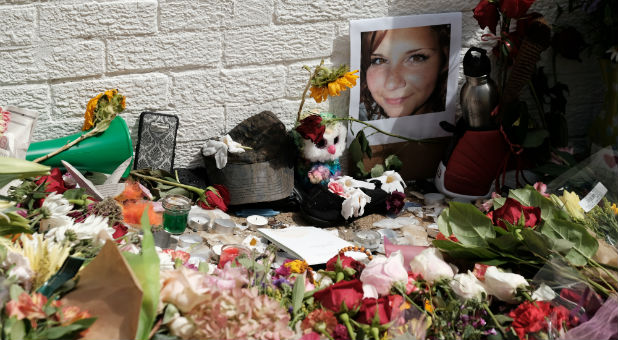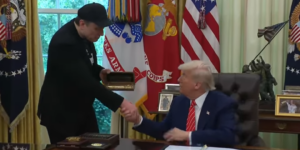‘Amazing Grace’ Hovers at Heather Heyer’s Funeral
With tears and defiant tributes, hundreds of purple-clad people packed an historic Charlottesville theater on Wednesday to remember the 32-year-old woman killed when a suspected white nationalist crashed his car into anti-racist demonstrators.
Heather Heyer, a paralegal whom colleagues said was devoted to social justice, was killed after clashes on Saturday between white nationalists attending a “Unite the Right” gathering and counter-protesters. James Fields, a 20-year-old Ohio man, has been charged with her murder.
“They tried to kill my child to shut her up. Well guess what? You just magnified her,” Heyer’s mother Susan Bro said to long and loud applause from those gathered at the city’s 1930s-era Paramount Theater.
Bro told the audience that her daughter’s favorite Facebook post was “If you’re not outraged, you’re not paying attention.”
“She paid attention. And she made a lot of us pay attention,” Bro said. “I want this to spread. I don’t want this to die. This is just the beginning of Heather’s legacy.”
The crowd later fell silent for the hymn “Amazing Grace,” sung while the sound of the sea played in the background. The singer, Barbara Edwards, wife of the pastor of the city’s Mt. Zion First African Baptist Church, said it evoked the singing of the anthem in the belly of a slave ship.
In the crowd were Virginia Governor Terry McAuliffe, U.S. Senator Tim Kane and Charlottesville Mayor Mike Signer. Many of those in attendance wore purple, her favorite color, at the request of Heyer’s family.
The theater’s marquee outside read: “Heather Heyer, gone but not forgotten.”
Wearing a violet polo shirt, his voice breaking with emotion, Heyer’s father, Mark Heyer, told the gathering how truly proud he was of his daughter.
“I came here today and I was overwhelmed by the rainbow of colors in this room,” he said. “That’s how Heather was.”
Hundreds of people held lit candles and sang songs of love and fellowship in Charlottesville later on Wednesday evening to remember Heather Heyer at what was billed as a vigil for unity.
STATUES AND SLAVERY
Fallout from Heyer’s death and the street fights among protesters has become President Donald Trump’s biggest domestic challenge. Trump was assailed from across the political spectrum over his initial response blaming “many sides” for the violence.
On Monday, the Republican president bowed to political pressure and denounced neo-Nazis and the Ku Klux Klan by name, but on Tuesday he again inflamed tensions by insisting counter-protesters were also to blame.
Residents of the usually quiet, liberal-leaning Virginia city were horrified by the violence they said was brought by outsiders.
White nationalists called Saturday’s rally to protest against plans to remove a statue of General Robert E. Lee, commander of the pro-slavery Confederate army in the U.S. Civil War.
Undeterred by the clashes, state and city leaders in several southern U.S. states have vowed to step up efforts to remove such monuments from public spaces.
Amid concerns trouble could erupt outside Wednesday’s memorial, a small group of anti-racist protesters wearing pink helmets and carrying baseball bats and purple shields stood quietly near the theater.
One of the group, who declined to be identified, said they brought weapons to defend themselves in case the white supremacists returned.
“The cops didn’t protect us on Saturday and we don’t trust them to do so today,” the group member said.
Also outside the theater, near where Heather Heyer was killed, artist Sam Welty was chalking a large portrait of her on a memorial wall that features many tributes to her.
“The way she lost her life, doing what she did, really stood for Charlottesville,” said Welty, 42.
In a tweet on Wednesday, Trump described Heyer as “beautiful and incredible … a truly special young woman. She will be long remembered by all!” {eoa}
© 2017 Thomson Reuters. All rights reserved.







































